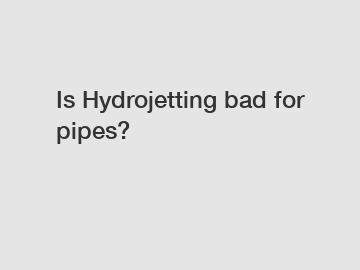Feb. 27, 2024
Energy
Is Hydrojetting bad for pipes?
Hydrojetting is a popular technique used for cleaning and unclogging pipes. It involves shooting high-pressure streams of water into the pipes to remove debris, blockages, and buildup. While hydrojetting is considered an effective method for maintaining pipe health, there are concerns about its potential impact on the pipes themselves. In this article, we will explore whether hydrojetting is bad for pipes and what factors can affect its safety and efficiency.
Benefits of Hydrojetting.

Hydrojetting offers several advantages when it comes to cleaning pipes. It is a non-invasive method that does not require the use of harsh chemicals or abrasive tools, making it environmentally friendly. The high-pressure water can effectively dislodge even the toughest blockages, including tree roots, grease, and mineral deposits. Hydrojetting can also help to extend the lifespan of pipes by preventing clogs and reducing the risk of corrosion.
However, despite its many benefits, some people have concerns about the potential risks associated with hydrojetting. The main worry is that the high-pressure water could damage the pipes, especially if they are old, corroded, or weakened by previous damage.
Impact on Pipe Materials.
One of the factors that can determine whether hydrojetting is bad for pipes is the material of the pipes themselves. While most modern pipes are designed to withstand the force of hydrojetting, older pipes made of materials such as clay, concrete, or Orangeburg may be more vulnerable to damage. These older materials are more likely to crack or collapse under the pressure of the water, leading to costly repairs.
It is essential to assess the condition of the pipes before deciding to use hydrojetting. A professional inspection can help determine whether the pipes are structurally sound enough to withstand the high-pressure cleaning. In some cases, alternative methods such as snaking or chemical cleaning may be more appropriate to avoid damaging the pipes.
Proper Use of Hydrojetting.
To minimize the risk of damage to pipes during hydrojetting, it is crucial to use the technique correctly. This includes ensuring that the water pressure is adjusted to the appropriate level for the type of pipes being cleaned. Excessive pressure can cause the pipes to weaken or burst, while insufficient pressure may not effectively remove blockages.
It is also important to work with trained professionals who have experience in hydrojetting. A skilled technician can assess the condition of the pipes, adjust the water pressure accordingly, and safely perform the cleaning without causing harm to the pipes.
Conclusion.
In conclusion, while hydrojetting can be a highly effective method for cleaning pipes, it is essential to consider the potential risks involved. Damage to pipes can occur if the technique is not used correctly, especially with older or fragile materials. However, with proper assessment, adjustment of water pressure, and skilled professionals, hydrojetting can be a safe and efficient way to maintain pipe health.
If you have any questions about hydrojetting or would like to schedule a pipe inspection, contact us today. Our team of experts is here to help ensure that your pipes remain in top condition.
Are you interested in learning more about Electric Heat Tracing Design, Sub-sea Pipeline Testing News, Flange Management Process? Contact us today to secure an expert consultation!
Previous: Is Single Phase to Three Phase Converters Improving Energy Efficiency in Residential Areas?
Next: Benefits of hybrid storage inverters in microgrids - worth the investment?
If you are interested in sending in a Guest Blogger Submission,welcome to write for us!
All Comments ( 0 )